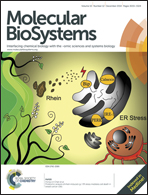Computational study of the structural plasticity and the ligand binding affinity of the IRES subdomain IIa†
Abstract
The internal ribosome entry site (IRES) of hepatitis C virus (HCV) drives noncanonical initiation of protein synthesis necessary for viral replication. In order to fulfil its role in HCV translation initiation its subdomain IIa should adopt an L-shaped conformation. However, according to the present knowledge, the bent topology of IIa would prevent the progression of the ribosome from initiation to productive translation. In order to be released from the ribosome, IIa should transform from the bended to an extended form. With the purpose to study the plasticity and stability of the IRES subdomain IIa we performed detailed molecular dynamics (MD) simulations of the ligand free RNA and its (native and mutated) complexes with the potential HCV inhibitors. We have shown that upon ligand removal conformation of the IIa subdomain changed from an extended into an L-shaped one during several tens of ns. Differently, binding of the benzimidazole translation inhibitors locked IIa in the extended conformation. On the other hand, the newly discovered translation inhibitor diaminopiperidine (DAP), in agreement with the experimentally based assumptions, stabilized IIa RNA in the bent conformation during MD simulations. Apparently the efficient locking of subdomain IIa in one form is one of the requirements the HCV RNA targeting drugs should fulfil.


 Please wait while we load your content...
Please wait while we load your content...